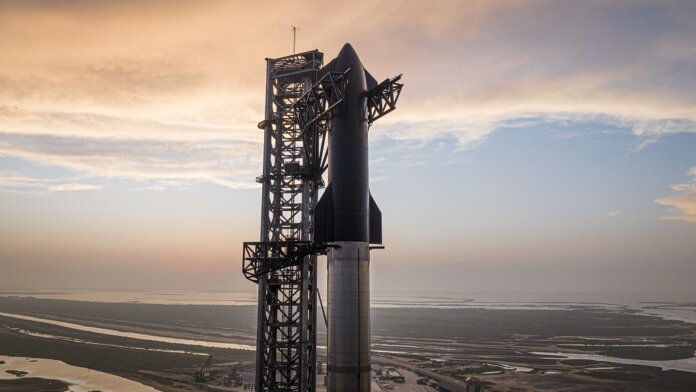SpaceX’s massive new Starship rocket is central to Elon Musk’s plans for humanity to become multi-planetary. It blasted off for its maiden flight yesterday but exploded shortly afterwards, marking a stuttering first step for the billionaire’s hopes of expanding further into the solar system.
The 394-foot rocket successfully lifted off from the company’s Starbase spaceport on the coast of South Texas at 8:28am local time, but almost four minutes into the flight it experienced what SpaceX referred to as a “rapid unscheduled disassembly.”
The problem seems to have been that the Starship upper stage failed to separate from the Super Heavy Booster, which caused the vehicle to tumble head over heels until it exploded. The company had planned for the vehicle to fly to an altitude of 146 miles before looping once around Earth and splashing down near Hawaii, but in the end it topped out at 20 miles.
Despite the setback, though, the mood at the company and the wider space industry was broadly positive. Failures are common in early flights of new rockets, so simply getting the vehicle off the ground is likely to be seen as a decent outcome.
“With a test like this, success comes from what we learn, and today’s test will help us improve Starship’s reliability as SpaceX seeks to make life multi-planetary,” SpaceX said in a tweet after the launch.
It probably shouldn’t have come as a surprise that the first proper launch of the Starship would end in a fireball. Several smaller prototypes had already exploded during testing, and with 33 raptor engines attempting to lift a combined 5,000 tons of fuel and spacecraft, this was a much bigger challenge. The company had also had to cancel a launch attempt on Monday due to a frozen valve.
“I don’t think anybody, Elon Musk included, expected this launch to go perfectly,” space analyst Laura Forczyk told New Scientist. “I would have been shocked if it had been 100 percent successful this first time.”
But plenty is riding on the company learning quickly from this failure. NASA has already awarded the company contracts for two upcoming missions in the agency’s Artemis lunar exploration program. The company has agreed to deliver modified versions of the Starship to help transport astronauts from NASA’s Orion space capsule to the lunar surface in 2025 and 2028.
With the agency having successfully flown its own SLS heavy launch vehicle late last year, the pressure is now on SpaceX to catch up. Its customer seems fairly relaxed for the time being, though. Following the launch, NASA administrator Bill Nelson tweeted: “Every great achievement throughout history has demanded some level of calculated risk, because with great risk comes great reward. Looking forward to all that SpaceX learns, to the next flight test—and beyond.”
NASA isn’t the only one invested in getting the Starship up and running. The reusable rocket is capable of lifting up to 150 tons of equipment into orbit, which can be extended to 250 tons if it’s only making a one-way trip. That could dramatically reshape the economics of getting into orbit.
“We have always been constrained in space flight by mass, volume, and cost,” Jennifer Heldmann, a planetary scientist at NASA’s Ames Research Center, told Nature. “And all of those constraints are basically lifted with Starship.”
A relatively cheap way of getting large amounts of material into space could help make some of SpaceX’s more ambitious goals achievable, such as building a permanent moonbase or helping create human settlements on Mars. Scientists are also excited about the prospect of being able to launch far more ambitious planetary probes or gigantic new telescopes that could greatly expand our understanding of the cosmos.
Before any of that can happen, though, SpaceX’s engineers have a lot of work to do to incorporate the lessons from this partial success. Given the company’s track record of spaceflight innovation, it may not be long before the Starship is blasting off again.
Image Credit: SpaceX



